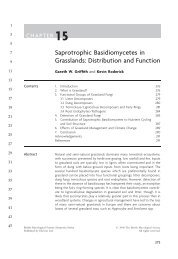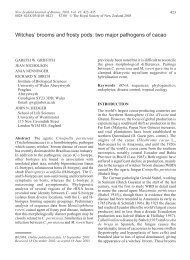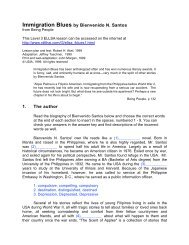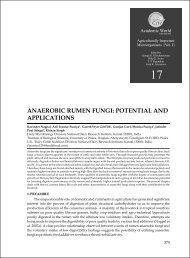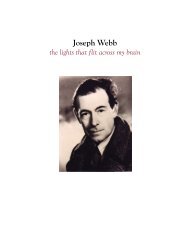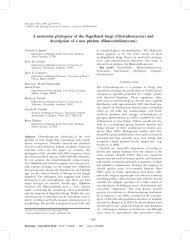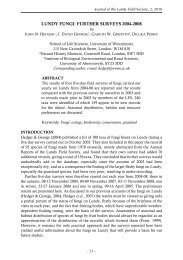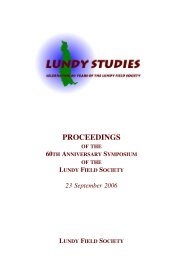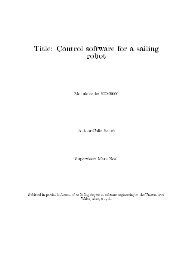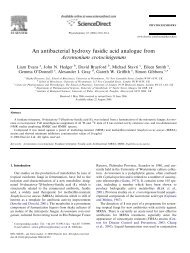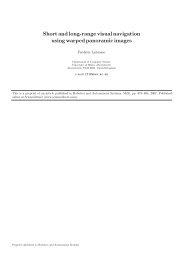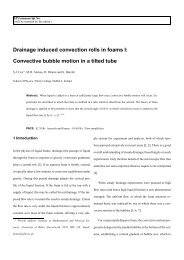Download the pdf - Users Site
Download the pdf - Users Site
Download the pdf - Users Site
You also want an ePaper? Increase the reach of your titles
YUMPU automatically turns print PDFs into web optimized ePapers that Google loves.
GRASSLAND AND HEATH HABITATS FOR FUNGI ON LUNDY<br />
Grassland and Heath vegetation covers most of Lundy and is <strong>the</strong> major terrestrial<br />
habitat. It is not however uniform. Hubbard (1997) divided <strong>the</strong> non-woody vegetation<br />
on Lundy into two categories: <strong>the</strong> Sidelands and <strong>the</strong> Plateau, and <strong>the</strong> same approach<br />
is followed here.<br />
The Sidelands<br />
Of <strong>the</strong> Sidelands, <strong>the</strong> east coast has <strong>the</strong> most species-diverse plant communities,<br />
especially on <strong>the</strong> shale slopes of <strong>the</strong> sou<strong>the</strong>rn end, where <strong>the</strong> Lundy cabbage,<br />
Coincya wrightii has its stronghold. Moving fur<strong>the</strong>r north along <strong>the</strong> east coast path<br />
into <strong>the</strong> granite geology, <strong>the</strong> dominance of rhododendron and <strong>the</strong>n bracken reduces<br />
<strong>the</strong> diversity of plants and associated fungi, although <strong>the</strong>re are a number of very<br />
interesting fungi in <strong>the</strong>se localities associated with <strong>the</strong> plant cover, for example hostspecific<br />
fungi on <strong>the</strong> rhododendrons, such as ‘purple leaf spot’ Cercoseptoria<br />
handelii and <strong>the</strong> aptly named ‘bud blast’, Pycnostysanus azaleae, which can be<br />
detected by its tiny pin-shaped spore structures on dead blackened flower buds. In<br />
contrast, <strong>the</strong> west and north coast Sidelands are much more exposed and botanically<br />
poorer, being dominated by just a few species, especially sea fescue (Festuca rubra)<br />
and sea pink (Armeria maritima), so it is also likely to have fewer species of fungi.<br />
Most of <strong>the</strong> species of macrofungi found on <strong>the</strong> granitic areas of <strong>the</strong> East<br />
Sidelands are also found on <strong>the</strong> Plateau, for example those associated with bracken,<br />
which dominates sideland areas such as Brazen Ward. These are mostly decomposer<br />
agarics growing as mycelia in <strong>the</strong> deep bracken litter, such as <strong>the</strong> bright orange<br />
Hygrophoropsis aurantiacus, ‘<strong>the</strong> false chanterelle’, (Plate 9) and grey-white species<br />
of Collybia and Clitocybe, <strong>the</strong> latter genus including <strong>the</strong> large, stoutly-stemmed,<br />
C. nebularis, ‘<strong>the</strong> clouded clitocybe’, which forms fruit body rings 2-3 m in diameter<br />
in <strong>the</strong> autumn in <strong>the</strong> bracken. In places where wet peaty soil occurs, especially in<br />
eroded exposures alongside <strong>the</strong> coast path around Gannets Bay, <strong>the</strong> tiny, but<br />
beautiful, pale-yellow agaric Omphalina (=Gerronema) ericetorum (Plate 10) fruits<br />
in small groups and was found to be abundant in our survey in April 2005. This<br />
fungus is associated with an alga which grows on <strong>the</strong> peat surfaces (=<strong>the</strong> lichen<br />
genus Coriscium). Areas of grass inside <strong>the</strong> bracken stands had some of <strong>the</strong><br />
grassland species also found on <strong>the</strong> plateau, but <strong>the</strong> beautiful yellow coral-like fruit<br />
bodies of Clavulinopsis corniculata were more abundant on <strong>the</strong> East Sidelands than<br />
on <strong>the</strong> Plateau in November 2004. A very unusual dwarf form of this fungus (Plate<br />
11) was also found at <strong>the</strong> same time on <strong>the</strong> West Sidelands in Festuca rubra turf<br />
near <strong>the</strong> North Light. Whe<strong>the</strong>r this is more widespread along <strong>the</strong> West Sidelands, or<br />
indeed if <strong>the</strong>re is a distinct decomposer community in <strong>the</strong> Festuca rubra/ Armeria<br />
maritima turf is yet to be determined. The decomposers like Clitocybe and Collybia<br />
found in <strong>the</strong> East Sidelands were not recorded in our brief surveys along <strong>the</strong> west<br />
coast: <strong>the</strong> small yellow/brown agarics in <strong>the</strong> genus Galerina, were <strong>the</strong> only common<br />
macrofungi, especially G. hypnorum, (Plate 12) fruiting amongst polytrichum moss.<br />
The majority of past records of plant pathogens are also from <strong>the</strong> East Sidelands<br />
(Hedger & George, 2004), reflecting <strong>the</strong> greater plant diversity. The rusts, (Uredinales)<br />
- 148 -



